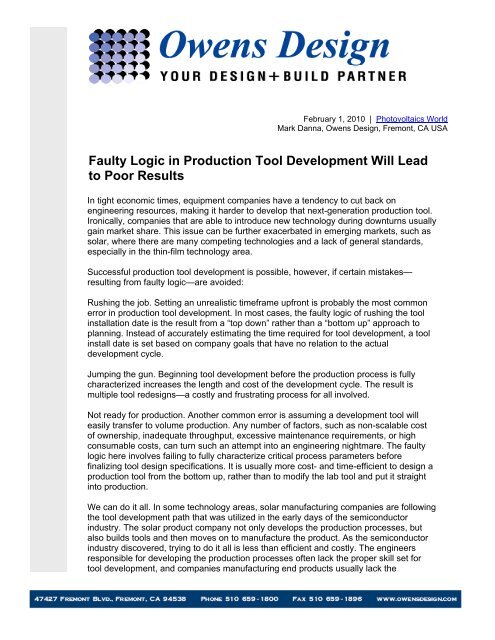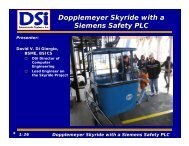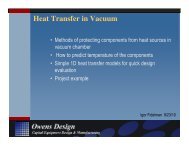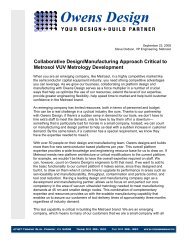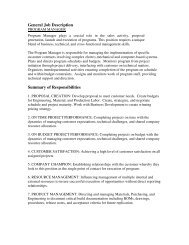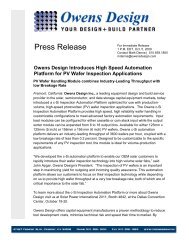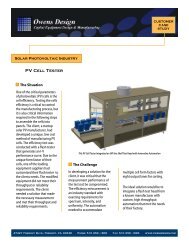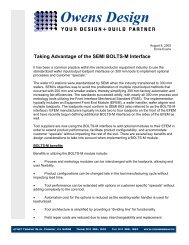Faulty Logic in Production Tool Development Will ... - Owens Design
Faulty Logic in Production Tool Development Will ... - Owens Design
Faulty Logic in Production Tool Development Will ... - Owens Design
Create successful ePaper yourself
Turn your PDF publications into a flip-book with our unique Google optimized e-Paper software.
February 1, 2010 | Photovoltaics World<br />
Mark Danna, <strong>Owens</strong> <strong>Design</strong>, Fremont, CA USA<br />
<strong>Faulty</strong> <strong>Logic</strong> <strong>in</strong> <strong>Production</strong> <strong>Tool</strong> <strong>Development</strong> <strong>Will</strong> Lead<br />
to Poor Results<br />
In tight economic times, equipment companies have a tendency to cut back on<br />
eng<strong>in</strong>eer<strong>in</strong>g resources, mak<strong>in</strong>g it harder to develop that next-generation production tool.<br />
Ironically, companies that are able to <strong>in</strong>troduce new technology dur<strong>in</strong>g downturns usually<br />
ga<strong>in</strong> market share. This issue can be further exacerbated <strong>in</strong> emerg<strong>in</strong>g markets, such as<br />
solar, where there are many compet<strong>in</strong>g technologies and a lack of general standards,<br />
especially <strong>in</strong> the th<strong>in</strong>-film technology area.<br />
Successful production tool development is possible, however, if certa<strong>in</strong> mistakes—<br />
result<strong>in</strong>g from faulty logic—are avoided:<br />
Rush<strong>in</strong>g the job. Sett<strong>in</strong>g an unrealistic timeframe upfront is probably the most common<br />
error <strong>in</strong> production tool development. In most cases, the faulty logic of rush<strong>in</strong>g the tool<br />
<strong>in</strong>stallation date is the result from a “top down” rather than a “bottom up” approach to<br />
plann<strong>in</strong>g. Instead of accurately estimat<strong>in</strong>g the time required for tool development, a tool<br />
<strong>in</strong>stall date is set based on company goals that have no relation to the actual<br />
development cycle.<br />
Jump<strong>in</strong>g the gun. Beg<strong>in</strong>n<strong>in</strong>g tool development before the production process is fully<br />
characterized <strong>in</strong>creases the length and cost of the development cycle. The result is<br />
multiple tool redesigns—a costly and frustrat<strong>in</strong>g process for all <strong>in</strong>volved.<br />
Not ready for production. Another common error is assum<strong>in</strong>g a development tool will<br />
easily transfer to volume production. Any number of factors, such as non-scalable cost<br />
of ownership, <strong>in</strong>adequate throughput, excessive ma<strong>in</strong>tenance requirements, or high<br />
consumable costs, can turn such an attempt <strong>in</strong>to an eng<strong>in</strong>eer<strong>in</strong>g nightmare. The faulty<br />
logic here <strong>in</strong>volves fail<strong>in</strong>g to fully characterize critical process parameters before<br />
f<strong>in</strong>aliz<strong>in</strong>g tool design specifications. It is usually more cost- and time-efficient to design a<br />
production tool from the bottom up, rather than to modify the lab tool and put it straight<br />
<strong>in</strong>to production.<br />
We can do it all. In some technology areas, solar manufactur<strong>in</strong>g companies are follow<strong>in</strong>g<br />
the tool development path that was utilized <strong>in</strong> the early days of the semiconductor<br />
<strong>in</strong>dustry. The solar product company not only develops the production processes, but<br />
also builds tools and then moves on to manufacture the product. As the semiconductor<br />
<strong>in</strong>dustry discovered, try<strong>in</strong>g to do it all is less than efficient and costly. The eng<strong>in</strong>eers<br />
responsible for develop<strong>in</strong>g the production processes often lack the proper skill set for<br />
tool development, and companies manufactur<strong>in</strong>g end products usually lack the
<strong>in</strong>frastructure to efficiently design and build capital equipment <strong>in</strong>-house. Even worse, the<br />
same eng<strong>in</strong>eers are often tasked with design<strong>in</strong>g the process and the production tool<br />
simultaneously. This typically extends development cycle and heightens costs, while<br />
result<strong>in</strong>g <strong>in</strong> a less than optimal production tool.<br />
Leverag<strong>in</strong>g outside expertise <strong>in</strong> areas such as product handl<strong>in</strong>g, automation, and<br />
software development can reduce development time and costs, while lett<strong>in</strong>g company<br />
process eng<strong>in</strong>eers focus on their core competencies.<br />
<strong>Tool</strong> cost is k<strong>in</strong>g. Decisions based purely on overall tool cost rather than optimized tool<br />
performance and ROI can result <strong>in</strong> outsourc<strong>in</strong>g tool development to a contract<br />
manufacturer (CM) <strong>in</strong> a low-cost region. For a variety of reasons, <strong>in</strong>clud<strong>in</strong>g lack of<br />
necessary skills on the part of the CM, and poor project coord<strong>in</strong>ation and<br />
communication, the likely result is a tool that fails to meet performance specifications<br />
and requires redesign.<br />
Each of the pitfalls described is likely to cause development time and cost overruns, as<br />
well as cost customer confidence. Each can be avoided by ensur<strong>in</strong>g all tool development<br />
decisions are based solely on ensur<strong>in</strong>g an effective tool development process.<br />
Mark Danna is senior director of bus<strong>in</strong>ess development at <strong>Owens</strong> <strong>Design</strong>, 47757 Fremont<br />
Blvd., Fremont, CA USA; 510-659-1800; mdanna@owensdesign.com


